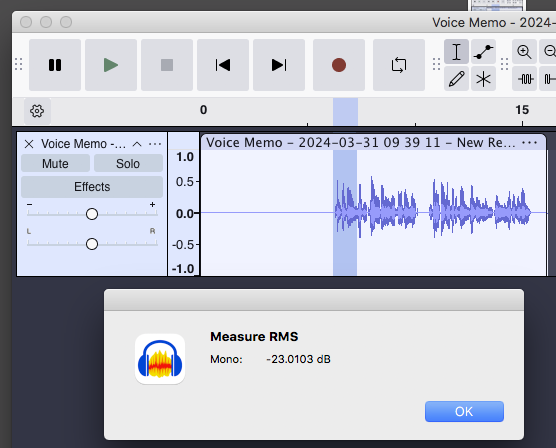Hi, I have some audio files from an hydrophone in which we are monitoring for certain sounds. However, I’ve been asked to show “how noisy” the environment is. Ideally, what they want is a number in dB. So for example, when we say a jet engine is 130dB. In this case, we are not asking for a particular sound but the average of the soundscape.
I know you need a sound level meter for this, but we don’t have it, so, is there a way to get it? I picked a sample from my audio and went to Analyze > Measure RMS and I get: Mono: -41.87 dB. How does this translate to what I want?
I have sounds up to 48kHz and some frequencies range between 120-140 dB (yes, it’s quite a noisy environment).
Any help will be very welcome and for the info, I’m not an acoustician so if someone replies, please, make it as if I were a 5 year old. Thanks in advance
You normally need an SPL meter but that’s not going to work under water. (There are also calibrated digital measurement mics.)
There are SPL meter phone apps, but the microphone in a phone isn’t precisely calibrated, if it’s calibrated at all an different phone models will be different. I wouldn’t trust one at all unless it has settings for different phones.
You might need some kind of calibrated hydrophone…
There is no “standard” calibration between dB SPL (acoustic) and dBFS (digital) because microphone sensitivity varies, preamp gain varies (and it’s usually adjustable with a knob), and ADC sensitivity varies.
However, there is a direct correlation… If the SPL level goes down by 10dB the digital level will also go down by 10dB, so calibration is possible.
But there’s one more “gotcha”… SPL measurements are usually A-Weighted (and short-term averaged) and the raw digital data is not. (As you may know, RMS is like an average but it’s not frequency weighted.) dB LUFS is frequency weighted but it’s different from A-Weighting.
And in case you don’t know this, the 0dB SPL reference is approximately the threshold of hearing and SPL levels are positive. 0dBFS is the “digital maximum” (with integer sample values) so digital dB levels are normally negative.
Thanks DVDdoug. I do have the hydrophone sensitivity, would that help?
I think DVDDoug is just illustrating how abysmally complicated this can be.
Do you know what the goal is? The audiobook standard for background noise is -60dB with no filters or shenanigans. Stop talking, hold your breath, and measure it. In English, the noise should be a thousand times quieter than your voice.
Open a sample of the performance with what you consider to be “non-performing background noise” in Audacity. Select a portion of it and Analyze > ACX-Check. Read the Noise Floor number. The first two numbers may not be valuable to you.
ACX-Check tool may be hiding under an Analyze setting. This can change when they issue a new Audacity version. This is why I recommend not doing an update in the middle of a production.
Koz
That’s dB-SPL, Sound Pressure Level in free air. That starts at 0 where you can’t hear anything and goes up.
Electronic noise starts at 0 where the electronics can’t get any louder and goes down. That one’s in negative numbers.
There is no handy, convenient, standard way to convert between them.
Koz
Hi Koz, thank you for your illustration. The goal is to know how does some operations underwater are perceived in the environment. Imagine like a hammer banging on a pipeline underwater. So instead of the actual noise of the hammer, they want to know how does the ambient noise increases with that hammer. Does that make sense?
I assume that’s given in millivolts at a certain dB level? (Regular microphones are usually specified at 94dB (1 Pascal).
That’s good, but not enough.
Exactly what other hardware do you have? I’m assuming the hydrophone doesn’t connect directly to your soundcard. (?)
It may be possible but you’ll probably need a multimeter (to measure a known voltage) and you might need to make a voltage divider (2 resistors) to create a known millivolt voltage.
The difference is valid. If you measure with and without the hammer you can simply subtract.
If this is “serious science” or legal compliance, you’ll need the proper calibrated and certified equipment.
Analyze > Measure RMS.
==============
=============
And that’s the reason you can’t use Audacity for Surveillance, Conflict Resolution or Law Enforcement.
Koz
This topic was automatically closed after 30 days. New replies are no longer allowed.



